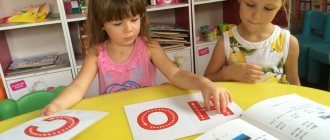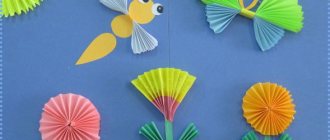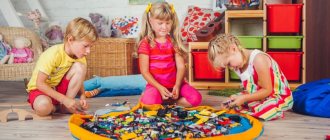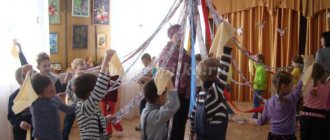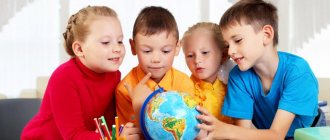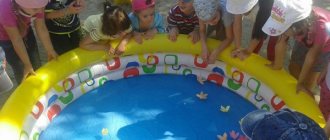Summary of a lesson in the preparatory group on preparing the hand for writing “Fun Competitions”
Goal: Development of attention, speed, reaction, motor dexterity, preparation of the hand for writing, development of accuracy of hand movements.
Materials: handouts (for each child): notebooks, a set of simple and colored pencils, chips of different colors, lacing, samples of graphic exercises “Geometric pattern”, “Rectangles”, “Superman”; medals for 1st, 2nd and 3rd place.
Progress of the lesson
Educator. - Children, today we will have a fun competition. For each correctly completed task, the child will receive a chip. At the end of the class we will tally your chips and award 1st, 2nd and 3rd place winners. Remember the main thing is that the task is completed correctly and accurately, and not quickly!
- But first, just as athletes warm up before real competitions, you and I will do a warm-up.
Dynamic pause
Warm-up begins We stood up, straightened our backs, leaned to the right - to the left And repeated again (bending to the sides) We squat in a count of One, two, three, four, five. This necessary work is to train the leg muscles (squats). And now we perform arm jerks together with you (arm jerks in front of the chest).
1st task “Geometric pattern” (children are given samples)
- Why do you think it is called that? (consists of geometric shapes).
For correctly completing the task, the child is given 1 chip.
2nd task “Rectangles”
- Be careful, each rectangle has its own pattern, you need to repeat it correctly.
For correctly completing the task, the child is given 1 chip.
3rd task Graphic dictation
- I will dictate half of the drawing, you must guess what it is and draw the second half.
(chips are distributed)
4th Lacing task “Repeat the pattern”
- You need to tie your own shoelaces, just like
shown in sample (sample showing)
For completing the task correctly, the child is given 1 chip.
5th task "Superman"
— Guys, you spent the whole year studying at the Obedient Pencil school. I believe that by the end of the year you have become real supermen. And I suggest you portray such a superman (showing a sample)
For completing the task correctly, the child is given 1 chip.
Result: Chips are counted and medals are distributed.
Summary of a lesson on preparing the hand for writing for preschoolers in the Snezhinka kindergarten
Goal: Development of attention, speed, reaction, motor dexterity, preparation of the hand for writing, development of accuracy of hand movements.
Material: illustrations with snowflake; handouts (for each child): notebooks, a set of simple pencils, spiky balls; pouch.
Progress of the lesson
Educator: Hello, guys! Look what I brought for you today (showing a picture with parts from a snowflake). Do you understand what this is? Yes, I think the same thing, that this is a snowflake, only unusual. Do you know why she is like this? The evil north wind broke our snowflake. And he said that we can return her only when we complete all his tasks. Let's help our snowflakes become beautiful again and shine for our joy? (Yes)
1st task
Then the 1st task. In order for the first ray of a snowflake to return to its place, you need to do a winter warm-up: (Children imitate walking in the snow, shoveling snow, making a snowman and playing with snowballs)
Educator: Guys, after completing the task, we will put one ray of a snowflake into this magic bag, which will then help us return our snowflake (we put the first ray of a snowflake in the bag).
2nd task. “Repeat the pattern!”
2. From sticks
.
Educator: Well done! Another ray saved from the evil north wind (put it in a bag).
3rd task. “Continue the drawing” (after completing the drawing, children are asked to independently complete the details (eyes, smile...))
Educator: Guys, I propose to draw a good wizard who will help us tame the north wind so that it doesn’t break anything else.
Educator: Well done, everyone did the task well! I hope the good wizard can help us. We place another ray of snowflakes in our magic bag.
4th task. “We’ll play with the snowball” (spiky ball)
- We will play with the snow and warm our palms. (Children roll the ball between their palms in different directions, squeeze the ball in their hands, throw it and catch it with both hands, then alternately with each hand)
Educator: Well done! The 4th ray is saved from the evil north wind (put it in a bag).
5th task. "Hatching"
Educator: Well done! The 5th ray is saved (put it in a bag). Last task left.
Educator: We have 1 ray left. To disenchant him, you must complete the most difficult task.
Tasks:
1. Educational.
- Preparing a child to learn to read and write.
- Continue work on drawing up proposals according to the diagram and writing them graphically,
- sound analysis of words,
- on preparing a child's hand for writing,
- for reading short texts and individual words,
- on solving puzzles.
- Development of coherent speech.
- Continue writing stories.
- Expand children's vocabulary by introducing such a concept as “valuable letter”.
- Familiarization with the surrounding world.
- Continue working to instill love and respect for animals.
- Develop children's cognitive abilities by introducing them to the animal world.
- Instill a love of reading and native language.
- Teach children to stay on task and work at a given pace.
- Instill in the souls of children such a moral concept as the ability to sympathize and empathize with animals.
- Instill respect for animals.
- conversation about planet Earth,
- writing letters to your favorite animals,
- excursion to the post office and getting to know its work,
- conversation: “How was the first letter written?”,
- conversation: “From the life of brands”,
- teaching children to read based on N.A. Zaitsev’s system.
- letter from the Arrogant Bunny,
- fairy-tale character “Postman Pechkin with a receipt”,
- a colorfully designed game book for every child,
- didactic material for compiling a sound analysis of a word,
- card with a graphically written sentence,
- card with the word "letter"
- cards with words (according to the number of children),
- white, gray, long-eared, long-legged, herbivorous,
- homeless, cautious, cunning, nimble, brave, fast,
- sensitive, lonely, boastful, cowardly, etc.,
- portrait of a hare.
- Show the richness and diversity of the Russian language by introducing adjectives into speech.
- Find out where they live, how hares are born and survive in this world that is unsafe for them.
2. Developmental.
3. Educational.
Preliminary work:
Equipment:
PROGRESS OF THE CLASS
Educator.
A surprise awaits you today.
Which? You will learn this from this card (shows a card with the word “letter”).
Remember, to avoid trouble, this word should not be spoken out loud.
So, you will read it to yourself. (Children read.)
And you will talk about this subject only with adjectives, as if asking a riddle.
Remember the game “Through the Mouth of a Baby”? Let's start! (The teacher continues.)
What is it?
In this task, the teacher, focusing on approximate answers to create a more complete picture of the letter, asks leading questions if necessary.
Educator.
See how many words you can find to say about the letter. And only the rich and powerful Russian language can do this.
The teacher summarizes. There is a knock on the door and the postman Pechkin enters.
Postman Pechkin.
Hello! Where is Dasha? She wrote a letter to the Hare, so he answered. I sent a valuable letter addressed to her.
He points his finger at the inscription on the envelope - the children are reading.
Educator.
What does valuable mean?
Pechkin.
This means that the sender
(reads)
Bunny-Zaznaika wants the letter to fall into the hands of the addressee, that is
(reads and shows)
Dasha.
Pechkin
(turns to Dasha) :
Sign this receipt
(shows)
. By the way, this service is paid. Did I deliver the letter to you? Delivered. It would be interesting to know what value this letter, photographs or documents contain, but I’m in a hurry, they promised to feed me buns in your kitchen.
Next, the letter is opened and Dasha reads it.
Dasha.
Hello Dasha! Sorry I didn't get to visit you. There were reasons for this. But you and the guys will learn about my life from my gift. I made a game for you. Play now! Goodbye! Your Bunny.
Game books are taken out of the envelope and distributed to the children. Everyone sits down at the table and work begins.
Educator.
Open your books donated by the Hare to the first page.
First page.
Educator.
What is the name of the game? The heron and the goat know that. Faster mind and sharper gaze - Lower the letters into the desired row.
Children complete the task in their books.
Educator.
We read together what happened in the bottom row. Right! Hare!
Second page.
Educator.
I began to get ready to visit. As soon as I went out to change my fur coat, the Squirrels started making noise.
The teacher gives the children a task:
Take pencils and write down graphically the following sentence: “Look, the ball is rolling!”
Children complete assignments in books.
Educator.
I blurted out to them: I’m not riding, but throwing off my gray fur coat. Do you know why the Hare answered the Squirrels this way?
The children answer.
Educator.
You will complete the next task of the Hare at home in this book. Your parents will read it and help you complete it.
The Hare's task.
Try to draw Squirrel and me rolling on the ground using the stroke method.
Third page.
Educator.
The squirrels began to shout that I was the Arrogant Bunny. I had to explain to them that I’m not arrogant. What do they care about! They live in their warm hollow, but I don’t even have a home. After all, we are born right on the ground, among the grass.
The teacher gives the children a task:
Do you see a hare drawn in squares in your books? Now draw it yourself, according to the sample.
Children complete the task in their books.
Educator.
To prevent Bunny from being lonely, draw his friends at home, according to the pattern, in the cells.
Fourth page.
Educator.
We were born and sat alone, while foxes and wolves ran past.
The teacher gives the children a task: read the highlighted word in your books (the word “Fear” is written in the books) and draw a diagram of the sound analysis of this word.
Educator.
I've finished it! – I thought. As soon as I said this word, it crumbled... You will write at home what words this word crumbled into.
Fifth page.
Educator.
I know one funny game “The little white bunny is sitting” based on poetry:
The little white bunny sits and wiggles his ears. Like this, like this, and wiggles his ears! It’s cold for the bunny to sit, I need to warm my paws - Paws up - paws down Pull up on your toes... Just stand on your tiptoes - Quickly, quickly they galloped.
Do you Dasha and your friends know this game? Can you think of other games?
The children answer.
Educator.
It's time for us to rest. Let's play.
An outdoor game is being played.
Educator.
At home with your parents, come up with a game and sketch it on this page. And you can call it “Hare exercise”.
Sixth page.
Educator.
I was sitting under a bush, and suddenly, from behind the Christmas tree, there it was, my mother came running! I really love what she has. And guess what exactly, you can guess for yourself by arranging the Christmas trees according to height.
The envelope on this page contains Christmas trees of different heights with letters. Children, completing the task, laying out the word “MILK”.
Educator.
My mother’s food is fatty and lasts for several days. And then you look, another hare runs by. After all, they feed all the bunnies that come their way. We sit like this for three weeks, and then we start taking care of ourselves.
Seventh page.
Educator.
We have many enemies, so we sleep with our eyes open. We don't build houses for ourselves. In the summer, we sit hidden under a bush, and in the winter we hide in the snow. It’s hard for a wolf to notice me in my white fur coat in the snow.
The teacher shows a tablet with a graphic image of a four-word sentence and invites the children to compose sentences with the word “wolf” according to a given pattern. The teacher’s task is to ensure that different sentences are drawn up according to the same scheme. Then the teacher invites the children at home with their parents to come up with a story on the topic: “How I met the hare.” This completes the work with the game book.
Educator.
I just have to give you the last message from Bunny. He wrote all these words to himself.
The teacher hands out cards with words to the children.
Children take turns going to the board, each with their own card, and read the word that is written on it. The teacher posts them on the board. Words on the cards: white, gray, eared, long-legged, herbivore, homeless, careful, cunning, etc.
| nimble, strong, fast, sensitive, lonely, boastful, cowardly, |
At the top above the cards is a portrait of Bunny, taken from the envelope.
Educator.
But we are not saying goodbye to the game. This is a gift from the Bunny, and it will remain with you. And yet, why did Bunny send a gift to each of you, and not just to Dasha?
Listening to the children's answers, the teacher leads them to the idea that the Hare has many enemies, but no defenders. So he is looking for friends.


